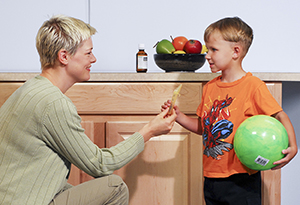Cellulitis (Pediatric)
Cellulitis in Children

What causes cellulitis?
Even a small cut, bite, or scratch can become infected by germs (bacteria). If this infection spreads to deeper layers of skin, it can become very serious. Cellulitis can affect any part of the body, but is often found on the face, arms, and legs. It cannot spread from person to person. Certain new forms of bacteria, called MRSA, can cause cellulitis in children even if there is no cut or scratch. So if a lesion develops that is red and painful, make an appointment for your child to see a doctor as soon as possible.
Symptoms of cellulitis
Call the healthcare provider right away if your child has any of these symptoms:
An area of skin that swells and is tender, painful, or warm
Fever over 100.4°F (38°C)
Headache, muscle aches, or joint stiffness
Hair loss around the infected area
Nausea and vomiting
Redness, bruise, blister, rash, or red streak on the skin that spreads from a cut, scratch, or bite
Swollen glands
Weakness or exhaustion
Treating Cellulitis
Cellulitis must be treated by a healthcare provider. Treatment may include the following:
A course of antibiotics. Make sure your child takes every dose on time. All the medicine must be finished, even if the child feels better.
Skin sample. Your child’s healthcare provider may take a sample of the area to check for MRSA or other bacteria.
Medicine for pain. Your healthcare provider may tell you to give either acetaminophen or ibuprofen. Or you may be told to alternate these medicines. Make sure you give either of these medicines as directed so you don’t give too little or too much. Don't give your child aspirin. Aspirin may cause Reye syndrome, a rare but potentially life-threatening condition.
Elevation of the affected area. Your child’s healthcare provider will tell you if this is necessary and for how long. If instructed, have your child keep the affected area still and elevated. If the area is on the arm or hand, it should be kept above the level of the heart. If the area is on the leg or foot, it should be kept above the level of the hip. This is done to reduce swelling and help the antibiotics work better.
The symptoms of cellulitis usually go away after a few days of treatment. For severe cellulitis, treatment must be done in the hospital. There, your child can receive antibiotics and fluids through an IV line. They will keep a close watch to make sure your child is comfortable and gets plenty of rest.
Updated:
October 03, 2017
Sources:
Bradley, JS. Nelson's Pediatric Antimicrobial Therapy. 2012-2013.(19)39., Practice Guidelines for the Diagnosis and Management of Skin and Soft Tissue Infections. Stevens, D. Clinical Infectious Disease. 2014;59(2):147-153.
Reviewed By:
Finke, Amy, RN, BSN,Image reviewed by StayWell art team.,Lehrer, Michael Stephen, MD